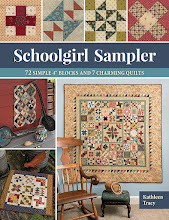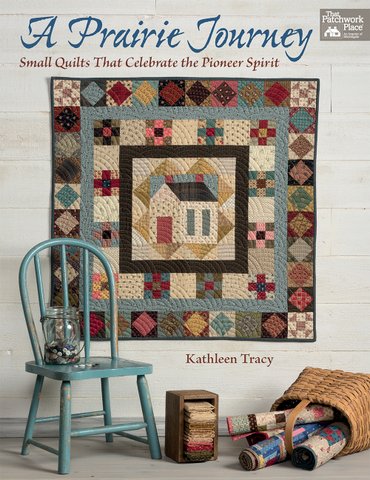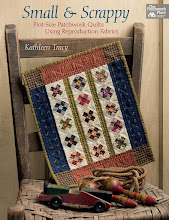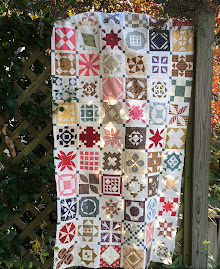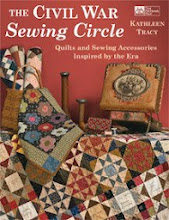If you haven't tried hand quilting, what's stopping you? Little quilts are perfect for practicing your hand quilting. I think it really adds something to these small projects and I always like to do my part to encourage quilters to try it. Even if the first one you try isn't all that good, keep at it and you'll get better. When I've been away from it for awhile and then pick it up again those first few lines of stitching are a little less straight than I'd prefer. But it comes back quickly and you pick up a certain rhythm if you do it long enough and get in the "zone." Straight-line quilting is often easy enough for beginners and if that doesn't quite do it for you, you can always try a quilting stencil to add a little more to your quilt.
Quilting stencils are easy to use with a water soluble marking pen or other type of fabric marker. Your local quilt shop probably carries stencils in different sizes along with marking tools. You can often find stencils at booths when you shop at the larger quilt shows. You can also find them online. The Stencil Company sells a nice variety of stencils for small quilt blocks and borders.
Quilting stencils are easy to use with a water soluble marking pen or other type of fabric marker. Your local quilt shop probably carries stencils in different sizes along with marking tools. You can often find stencils at booths when you shop at the larger quilt shows. You can also find them online. The Stencil Company sells a nice variety of stencils for small quilt blocks and borders.
This little wavy stencil is one of my favorites and I like to use it often. Simple, but a little bit special without overpowering the border.
I don't ever plan on winning any prizes in a show for my hand quilting. I'm not afraid to admit that I still enjoy making things even if I'm not perfect at them. If I waited until I did things perfectly I'd never make anything! A friend of mine said she thought all hand quilting was always supposed to be done free hand (Lord no!) and so she was hesitant to try it because she had no skills and was afraid she'd never get her lines straight.
If this is what's keeping you from trying it - take advantage of tools that make quilting easier. There's a product called Tiger Tape that really helps you learn to space your stitches evenly if you're just beginning. You line up the tape along the place you want to stitch and then follow the markings on the tape to keep your stitches in line. If it helps you stitch straighter lines, why not use it? There's no rule that says quilting has to be done a certain way except among the purists or if you're entering your quilt in a show. Then, of course, it matters and it should be perfect. But, if you're just beginning and hesitant to try for this reason - remember, in the 19th century, some wonderful antique quilts were hand quilted. If you take a close look, you'll see that not all of them were necessarily quilted with exceptional skill. Even the average quilter hand quilted her quilts. We all have to begin somewhere and the point is to enjoy the process. You get better with practice.
If you do become inspired to try hand quilting, you can try several different pens or pencils to mark your stitching lines. I've tried but don't especially care for the colored lead pens or pencils. I've also tried a chalk marker but didn't like that very much either. But that's just me. I have not tried a Frixion pen yet. Despite my preferences, some of these may be good options for you so try them and see. You need to find what works best for YOU. After trying several different products, I prefer to use a use a fine-point washable quilt marking pen and have found several made by the Clover company that work well and wash out nicely. I use a Clover blue water-soluble marking pen on lighter fabrics and a Clover white pen for marking my darker fabrics.
Here's a tip: Whichever marking tool you try, follow the directions on the package. If you decide to use a washable marker, after you finish quilting, do not press or place your quilt in the dryer until you are sure that all of the markings have been washed out. I have almost ruined a quilt by not being careful. Depending upon the pen, some markings will be set with HEAT and won't come out easily. (The Frixion pen markings apparently disappear with heat and reappear when cold so again, check the directions.) Just take your time, put on your glasses so you can see the lines (that's a reminder to myself!) and gently wash the top of the quilt with a damp cloth until all of the markings are off. Then, let it air dry. If you can still see some marks, wash it again.
If you think hand quilting is difficult, try it before you decide it's not for you. It really doesn't have to be perfect - you will get better with practice. Or, maybe, like me, you'll find that it won't matter if your stitches aren't perfect. My intentions are always good, but sometimes quirky, childlike stitches suit me just fine.
Border stencils that measure 2 or 2.5 inches are perfect for quilting the borders of small quilts.
You can also find stencils in many different sizes that match the size of your blocks.
Go ahead - mark the lines with your preferred marking tool.
Then, stitch on the lines with quilting thread (more on that topic next week).
Follow the directions on the pen or pencil to erase or wash off the markings. I always play it safe and use cold water instead of hot when I wash mine. The little quilt you see above is one of my favorites and it's included in my new book. I took my time last year while I was making all of those quilts and had fun quilting most of them by hand.
If I use a simple quilting design, it usually takes a couple of evenings or a week at most to finish a small quilt if I keep at it every day. I am clearly not an expert and my stitches could be a little smaller and straighter for sure but it's still so much fun to sit and stitch and see what the quilting adds to finishing a quilt. It doesn't have to be heavily quilted - straight lines or Xs are perfectly fine. Even a little bit of hand quilting will give a special look to your quilt. As a matter of fact, I prefer less rather than more quilting on my quilts so it doesn't detract from the quilt as a whole. And, don't forget, if you make a mistake or find that your stitches are quirky or a little less than perfect - Oh well, try not to worry too much. Antique doll quilts were not perfect either. We're just having fun here.
Papa's Shirts doll quilt club patterns for August were mailed out early this week so they should be arriving in your mailbox soon.

















































